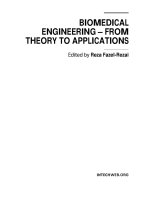Biomedical Engineering From Theory to Applications Part 17 docx
Bạn đang xem bản rút gọn của tài liệu. Xem và tải ngay bản đầy đủ của tài liệu tại đây (1.45 MB, 18 trang )
Biomedical Engineering – From Theory to Applications
470
describe how strains and stresses are distributed within a cell (Karcher et al., 2003; Vaziri et al.,
2007). The disadvantage of a continuum model lies in its ability to deal with discrete
components, such as cytoskeletons, making it difficult to interpret the mechanical behaviours
and interactions with discrete components, and their contribution to the mechanical properties
of a cell. In contrast to the continuum approaches, discrete approaches treat the cytoskeleton
as the main structural component and have been developed, in particular, to investigate the
cytoskeletal mechanics in adherent cells (Satcher and Dewey, 1996; Stamenović et al., 1996).
The microscopic spectrin-network model was developed for suspended cells, such as
erythrocytes, to investigate the contribution of the cell membrane and spectrin network to the
large deformation of red blood cells (Boey et al., 1998; Li et al., 2005). The tensegrity model
consists of stress-supported struts, which play the role of microtubules, and cable-like
structures, which play the role of actin filaments (Ingber, 2003). The tensegrity model depicts
the cytoskeleton as a prestressed network of interconnected filaments, investigating the effects
on cellular shape and stiffness (Stamenović et al., 1996). Because the tensegrity model is quite
conceptual and does not consider other cellular components, such as the cell membrane and
cytoplasm, difficulties arise when relating its findings to the physical relationships between the
mechanical properties of a whole cell and its subcellular components.
1.3 Basic concept of the mechano-cell model
The mechanical properties of a cell are the result of the structural combination of subcellular
components, such as the cell membrane, nuclear envelope, and cytoskeleton. To understand
the underlying process of how these subcellular components contribute to the cell as a
whole, it is essential to develop a cell model that displays continuum behaviour as a whole.
Although one way to express the continuum nature of a cell is to use the continuum model,
this has difficulties considering discrete elements, such as the cytoskeleton, which may
reorient passively concomitant with cell deformation. Thus, we depict a cell as an assembly
of discrete elements, including a cellular membrane, in an attempt to express the continuum
behaviour of the cell as a whole. Using computational biomechanics in conjunction with
experimental measurements, it should be possible to establish a new platform that helps to
provide a more complete picture of cellular remodelling rather than the collection of
information being solely dependent on the measurement technology.
2. Development of the mechano-cell model
2.1 Overview
We have developed a cell model, termed the "mechano-cell," that is capable of simulating
the mechanical behaviour of a cell (Ujihara et al. 2010a). As shown in Fig. 1, the model
Cell membrane (CM)
Nuclear envelope (NE)
Cytoskeleton (CSK)
Fig. 1. Overview of the mechano-cell model.
A Mechanical Cell Model and Its Application to Cellular Biomechanics
471
consists of the cell membrane (CM), nuclear envelope (NE), and cytoskeletons (CSKs). The
model changes shape such that the sum of the various elastic energies generated during cell
deformation converges towards a minimum.
2.2 Modelling of a cell membrane and a nuclear envelope
The CM and NE are lipid layers, reinforced with cytoskeletal networks (Fig. 2). The
cytoskeletal networks are firmly anchored to the CM and NE via various transmembrane
proteins and/or membrane-associated proteins. It was thus assumed that the cytoskeletal
network would not tear from the CM and NE.
Lipid bilayer
Transmembrane
p
rotein
Cytoskeleton
Fig. 2. Phase-contrast micrograph of a floating cell and schematic of the cell membrane
structure. Scale bar = 10 μm.
In this study, the mechanical nature of the cytoskeletal network was included in the model
of the CM and NE. The cytoskeletal networks beneath the CM and NE are known to resist
in-plane deformation (stretch and area change), whereas the lipid bilayer is relatively
permissive to in-plane deformation (Mohandas and Evans, 1994). Moreover, the CM and
NE within cytoskeletal networks resist bending because of their thickness.
Spring network modelling was adopted to express the mechanical nature of the CM and NE
(Wada and Kobayashi, 2003). Figure 3(a) shows the networks of the CM and NE and Figure
3(b) illustrates a magnified view of the triangular meshes. The black dots on the vertexes of
the mesh are nodes, and are linked by a spring of spring constant k
s
. Neighbouring
elements are connected with a bending spring of spring constant k
b
to prevent membrane
folding. r
i
is the positional vector of the node i, n
l1
and n
l2
are normal vectors to individual
neighbouring meshes, and θ
l
is the angle between n
l1
and n
l2
. The stretching energy W
s
and
bending energy W
b
generated are modelled as
s
N
i
jjss
LLkW
1
2
0
)(
2
1
(1)
2
1
1
tan
22
b
N
l
bbl
l
WkL
(2)
where N
s
and N
b
are the number of springs for stretching and bending, and L
0j
and L
j
are the
lengths of the spring in the natural state after deformation. The tangent function is adopted
in eq. (2) to infinitize the energy when the membrane is completely folded (θ
l
= π). By vector
analysis, we rewrote eq. (2) as
Biomedical Engineering – From Theory to Applications
472
12
12
1
1
1
21
b
N
ll
bbl
ll
l
WkL
nn
nn
(3)
The resistances to changes in the surface area of the whole membrane and to an area change
of a local element are both modelled. The former corresponds to the situation whereby lipid
molecules can move freely over the cytoskeletal network, while the latter corresponds to the
situation where movement of the lipid molecules is confined to a local element. The area
expansion energy W
A
is thus formulated as a summation of the energy due to a change in
the whole membrane area and due to a change in the local area:
2
2
00
00
00
1
11
22
e
N
ee
A
Aae
e
e
AA A A
Wk Ak A
AA
(4)
where A is the area of the whole membrane, subscript 0 denotes the natural state, and k
A
is a
coefficient for the whole area constraint, A
e
is the area of the element, k
a
is a coefficient for
the local area constraint, and N
e
is the number of elements. The total elastic energy stored is
thus expressed as:
jj
jj
s
A
b
WWWW (5)
where j denotes CM (j = c) and NE (j = n).
n
l1
i
r
i
k
s
θ
l
k
b
n
l2
e
l
(b)(a)
n
l1
i
r
i
k
s
θ
l
k
b
n
l2
e
l
(b)(a)
Fig. 3. (a) Mesh of the cellular membrane and nuclear envelope and (b) mechanical model of
the cell membrane.
2.3 Modelling of CSK
As demonstrated in various studies (Wang, 1998; Nagayama et al., 2006), CSKs play a
pivotal role in cellular mechanics. The CSK consists primarily of actin filaments,
microtubules, and intermediate filaments (see Fig. 4). Here, these were modelled as CSK
regardless of the type of cytoskeletal filament. For simplicity, a CSK is expressed as a
straight spring that generates a force as a function of its extension. The energy W
CSK
generated is thus modelled as
2
0
1
1
()
2
CSK
N
CSK CSK i i
i
Wk ll
(6)
where k
CSK
is the spring constant of the CSK, l
0i
and l
i
are the length of CSK
i
at the natural
state and after deformation, and N
CSK
is the total number of CSKs.
A Mechanical Cell Model and Its Application to Cellular Biomechanics
473
(a) (b) (c)
Fig. 4. Confocal laser scanning micrographs of (a) actin filaments, (b) microtubules and (c)
intermediate filaments in adherent fibroblasts. Scale bar = 50 μm.
2.4 Interaction between the cell membrane and nuclear envelope
The organelles and cytosol are present between the CM and NE. The interaction between
the CM and NE is expressed by a potential function with respect their distance apart. Figure
5 shows a conceptual diagram and potential function of the interaction between the CM and
NE. We define the potential energy Ψ
ij
between node i on the CM and node j on the NE as
ij
tan ( 1 0)
22
Ψ
0(0)
ij ij
nij
ij
yy
ky
y
(7)
where k
n
is a parameter to express the interaction between the CM and NE, and
y
ij
= (d
ij
– d
0
)/d
0
, d
ij
is the distance between node i on the CM and node j on the NE, and d
0
is
the difference in the radius between the CM and NE at their natural state. The total
potential energy Ψ is calculated by taking a summation of Ψ
ij
as
11
ΨΨ
cn
nn
NN
i
j
ij
(8)
where
c
n
N and
n
n
N are the number of nodes on the CM and NE, respectively.
-1 0 1
Potential energy Ψ
ij
Distance ratio y
ij
Nuclear envelope
d
ij
ji
Cell membrane
Nodes
Cell membrane
Nuclear
envelope
Fig. 5. Interaction between the cell membrane and nuclear envelope.
Biomedical Engineering – From Theory to Applications
474
2.5 Minimum energy problem
The shape of the CM and NE can be determined from the elastic energies of the CM, NE,
and CSKs, and from the interaction between the CM and NE if we provide constraints on
the volumes encapsulated by CM
c
V and NE
n
V . By vector analyses, energies (5), (6), and
(8) are rewritten as functions of the positional vector of nodal points
r
i
. Thus, the shape of
the CM and NE were determined as a minimum energy problem under a volume constraint.
Mathematically, this is phrased as calculating the positional vectors that satisfy a condition
such that the total elastic energy
W
t
is minimum, under the constraint that the volume
c
V
and
n
V are equal to
0
c
V and
0
n
V
Minimize
W
t
with respect to r
i
Ψ
cn
tCSK
WW W W
(9)
subject to
c
V =
0
c
V and
n
V =
0
n
V
where superscript
c and n denote the CM and NE, and subscript 0 denotes the natural state.
A volume elastic energy
W
V
is introduced as
2
0
0
0
1
2
jj
jj j
VV
j
VV
Wk V
V
(10)
where j denotes the CM (j = c) and NE (j = n), and k
V
is the volume elasticity. Including eq.
(10) in the minimum energy problem, eq. (9) is rewritten as
Minimize W with respect to
r
i
Ψ
cn cn
CSK V V
WW W W W W
(11)
2.6 Solving method
A cell shape is determined by moving the nodal points on CM and NE such that the total
elastic energy W is minimized. Based on the virtual work theory, an elastic force
F
i
applied
to node i is calculated from
i
i
W
F
r
(12)
where
r
i
is the position vector of i. The motion equation of a mass point with mass m on
node i is described as
iii
m
rrF
(13)
where a dot indicates the time derivative, and
is the artificial viscosity. Discretization of
eq. (13) and some mathematical rearrangements yield
1
NN
N
ii
i
m
m
vF
v
(14)
where
v is the velocity vector, N is the computational step number, and
is an increment of
time. The position of node i
1N
i
r
is thus calculated from
A Mechanical Cell Model and Its Application to Cellular Biomechanics
475
11NNN
iii
rrv
(15)
2.6 Procedure for computation
A flowchart for the simulation is illustrated in Fig. 6. The flowchart has two iterative
processes. The external loop is a real-time process, while the internal loop is instituted to
minimize the elastic energy by a quasi-static approach. Based on the virtual work theory, an
elastic force
F
i
applied to node i is obtained from eq. (12). It is followed by updating the
positional vector
r of the nodal points by eq. (15) and calculating the total elastic energy W.
If a changing ratio of the total elastic energy W is smaller than a tolerance
, the boundary
conditions are renewed to proceed to the next real-time step. If not satisfied, force
F and
positional vector
r
N
of the nodal points are repeatedly calculated under the same boundary
conditions.
START
Update node position r
N
Calculate the total elastic energy W
N
Calculate F
Yes
No
t = t+δ
Update boundary conditions
Define parameters
N = 0
N = N+1
?
1
N
NN
W
WW
Internal loop
(Quasi-static process)
Define the initial position of all nodes
External loop
(Real-time process)
Fig. 6.
Flowchart for the mechanical test simulation.
2.7 Parameter settings
The CM and NE were assumed as spheres at their natural state, with a diameter of 20 m and
10
m, respectively. In the model, N
s
and N
b
= 519,
c
n
N and
n
n
N = 175, N
e
= 346,
N
CSK
=
200 and
= 1.010
6
g/s. For the CM, m = 1.010
-9
g, k
s
= 5.610
5
g/s
2
,
k
b
= 9.010
3
gm/s
2
, k
A
= 2.710
7
g/s
2
, k
a
= 3.010
6
g/s
2
, k
V
= 5.010
6
g/(ms
2
). For the
NE, the mass was set to half of the CM, while the other parameters were set to double the CM.
Biomedical Engineering – From Theory to Applications
476
The spring constants k
s
, k
A
, and k
a
were estimated by the tensile test simulations such that
the elastic energy generated in the mechano-cell equaled the strain energy W
D
obtained
when the CM was modelled as a continuum. According to the theory of continuum
mechanics, the strain energy W
D
is defined as
1
1
2
e
N
De
e
WAh
T
ee
ε Dε
(16)
where N
e
is the number of elements, A
e
is the area of each element, and h is the thickness of
the CM,
e
T
= (
Xe
,
Ye
,
XYe
) is the strain vector of each element. D is the elastic modulus
matrix under a plane strain condition. The parameters in eq. (16) were set to h = 0.5 m,
elastic modulus of the CM E
CM
= 1000 Pa, and Poisson’s ratio v = 0.3 by reference to
Feneberg et al. (2004) McGarry et al.
(2004), and Mahaffy et al.
(2004). Note that the elastic
modulus and Poisson’s ratio appear in the elastic modulus matrix D.
02 46 810
0
0.1
0.2
0.3
0.4
0.5
Cell deformation D (μm)
Energy W (pJ)
W
s
+ W
A
W
D
Fig. 7. Elastic energy of the in-plane deformations (W
s
+ W
A
) stored in the mechano-cell
(solid line) and the strain energy W
D
obtained when the CM was modelled as a continuum
(dashed line).
The spring constant of the bending spring k
b
was determined such that the bending energy
W
b
calculated from eq. (2) at the initial state of the cell equaled the bending energy W
B
analytically calculated (Wada and Kobayashi, 2003). Analytically, the bending energy W
B
of
a sphere is given by
2
12
1
()
2
B
WBCCdA
(17)
where B is the bending stiffness and C
1
and C
2
are the principal curvatures. Applying eq.
(17) to the cell, allowing Ω to be CM and given that B = 2.010
-18
J (Zhelev et al., 1994) and
C
1
= C
2
= 1/R
0
(R
0
= 10 m, initial radius of a cell), it follows that k
b
= 9.010
3
gm/s
2
.
The spring constant of the CSK k
CSK
was set to 1.510
6
g/s
2
, based on the elastic modulus of
an actin bundle (Deguchi et al., 2005). The CSKs were assumed to have a natural length
when the cell was in its natural state. The CSKs were chosen randomly from all possible
candidates of CSKs that were made by connecting two nodes on the CM. The spring
A Mechanical Cell Model and Its Application to Cellular Biomechanics
477
constants of the volume elasticity (k
V
) were determined to assure cell incompressibility.
Because no data is presently available for k
n
, it was determined that the load-deformation
curves obtained by the simulation, fit the range of the experimental data.
3. Tensile tests
3.1 Tensile tests
The mechanical behavior of a cell during a tensile test was simulated. The tensile test was
simulated by fixing the nodes of CM at one side, while moving those at the opposite side in
the direction of cell stretching.
3.2 Simulation results
Figure 8 shows the deformation behaviour of a cell in the tensile test where a fibroblast is
stretched, obtained by simulation of the model (left) and experimentally (right). Similar to
the experimental data, the simulation showed that the cell and nucleus were elongated in
the stretched direction. CSKs were randomly oriented prior to loading and were passively
aligned in the stretched direction as the cell was stretched.
Computational Experimental
Nucleus
Cell
Nucleus
CSK
Cell
(µm)
010203040
(µm)
0102030
40
Fig. 8. Snapshots of a cell during the tensile test simulation (left) and experimental system
(right). The scale is indicated at the bottom of the figure.
Load-deformation curves obtained from the simulation and experimental systems are
presented in Fig. 9. Note that, in addition to the model with randomly oriented CSKs (Fig.
8), the data obtained from the models with parallel-oriented, oriented, and perpendicularly
oriented CSKs, in addition to with no CSK are presented for comparison. The curve
obtained from the simulation of the model with randomly oriented CSKs appeared to
increase non-linearly. The curve of the model with randomly oriented CSKs lay within the
variation of the experimentally obtained curves (simulation = 0.48 μN, experimental = 0.43-
1.24 μN at 20 μm cell deformation). Moreover, the curves obtained from the experiments
were between the curve of the parallel-oriented model and that of perpendicularly oriented
model.
Biomedical Engineering – From Theory to Applications
478
Load F (μN)
Cell deformation D (μm)
01020
0
0.2
0.4
0.6
0.8
1.0
155
Parallel-oriented
model
Perpendicularly oriented model
Randomly oriented model
No CSK model
Experiments (n = 10)
Fig. 9. Load-deformation curves obtained from the simulation and experimental system
(n = 10).
0
0.01
0.02
0.03
0.04
0-5 5-10 10-15 15-20
Stiffness S (N/m)
Cell deformation D (μm)
Fig. 10. Changes in cell stiffness of a model with randomly oriented CSKs with cell
deformation.
An increase in the cell stiffness with cell elongation is manifested from Fig. 10 that illustrates
the cell stiffness (S) of a model with randomly oriented CSKs between 0–5, 5–10, 10–15, and
15–20 μm deformation (D). The cell stiffness (S) increased by ~1.5-fold as the cell
deformation (D) increased from 0 to 15 µm, while decreases were evident if the cell was
stretched further.
The increase in cell stiffness with cell elongation is explained by the realignment of CSKs.
Figure 11 provides a histogram of the existence probability of the orientation angles (P
θ
)
A Mechanical Cell Model and Its Application to Cellular Biomechanics
479
of the CSKs of a randomly oriented model at a cell deformation (D) of 0, 10, and 20 µm.
The CSKs at D = 0 µm were distributed uniformly over all angles. With elongation of the
cell, the distribution of the orientation angle of the CSK became skewed towards 0° (Fig.
11), demonstrating that the CSKs tend to become passively aligned in the stretched
direction. This passive re-alignment gradually increased the elastic resistance of the
whole cell against the stretched direction, causing the load-deformation curve to be non-
linear (Fig. 9).
0
0.1
0.2
0.3
30 60 900
CSK orientation angle
θ (deg)
Probability P
θ
0
0.1
0.2
0.3
30 60 900
CSK orientation angle
θ (deg)
Probability P
θ
0
0.1
0.2
0.3
30 60 900
CSK orientation angle
θ (deg)
Probability P
θ
(a) (b) (c)
Fig. 11. Histogram of the existence probability of the orientation angles P
θ
of the CSK the
randomly oriented model during a cell deformation (D) value of (a) 0, (b) 10, and (c)
20 µm.
Not all the CSKs were stretched as the cell elongated. Figure 12 shows a histogram of
stretch ratios P
λ
of the CSK of the randomly oriented model at a deformation D of 0, 10, and
Probability P
λ
0
0.2
0.4
0.6
0.8
1.0
CSK stretch ratio λ
Probability P
λ
0
0.2
0.4
0.6
0.8
1.0
CSK stretch ratio
λ
Probability P
λ
0
0.2
0.4
0.6
0.8
1.0
CSK stretch ratio λ
(a) (b)
(c)
Fig. 12. Histogram of the stretch ratio P
λ
of the CSK of the randomly oriented model at a cell
deformation (D) value of (a) 0, (b) 10, and (c) 20 µm.
Biomedical Engineering – From Theory to Applications
480
20 µm. As evident in Fig. 12 (a), the stretch ratio of all CSKs was 1 at a deformation D of
0 µm. Elongation of the cell resulted in the broadening of the distribution towards both
positive and negative values of the stretch ratio, indicating that compressed, as well as
stretched CSKs were present while the cell was stretched. A combination of these stretched
and compressed CSKs, in addition to the shapes of the CM and NE, determine the
mechanical properties of the whole cell. Thus, although all subcellular components,
including CSKs, are expressed by a linear elastic element, the cell as a whole appears to
display clear non-linear deformation properties.
3.3 Summary
In this section, a cellular tensile test was simulated, using the cellular model, to investigate
the effects of mechanical behaviours of the subcellular components on the mechanical
properties of the cell. Analysis of the mechanical behaviours of the CSKs showed that they
were randomly oriented prior to loading, and tended to become passively aligned in the
stretched direction. These results attribute the non-linearity of the load-deformation curve
to a passive reorientation of the CSKs in the stretched direction.
4. Compressive tests
4.1 Compressive tests
A compressive test was simulated on the basis of the compressive experiment (Ujihara et al.,
2010b). Contact between the plate and cell was assumed when a node on the CM came to
within 0.01 μm of the plate. Once contacted, the node was assumed to move together with
the plate. Spring constants to express the interaction between the CM and NE and the
volume elasticity were set to 8.010
5
gm/s
2
and 5.010
5
g/(ms
2
), respectively. Other
parameters were identical to those defined in Section 2.7.
4.2 Simulation results
Figure 13 presents snapshots of a cell during cell deformation, with values of D = 0, 4, and 8
μm. While the cell was initially spherical, as it compressed, it elongated vertically due to the
Poisson’s effect by which a cell retains its volume. The CSKs that were oriented randomly
prior to loading appeared to be passively aligned in a direction perpendicular to the
compression.
D = 0 μm D = 4 μm D = 8 μm
Fig. 13. Snapshots of the mechano-cell model with CSKs during the compressive test.
A Mechanical Cell Model and Its Application to Cellular Biomechanics
481
Similar to the tensile test, the load–deformation curves of the model obtained by the
simulation and experimental systems were assessed in Fig. 14. Here, the results from a cell
model in the presence or absence of CSKs are presented. The load required to compress the
model with CSKs was larger than that for the model without CSKs. However, regardless of
the presence of CSKs, the load increased non-linearly as the cells were compressed, similar
to that observed in the experimental system. The curve of the model with CSKs was within
the variation of the experimental results.
0 2 4 6 8
0
10
20
30
Cell deformation D (μm)
Load F (nN)
Experiments with
intact cells (n = 7)
Simulation of the model
with CSKs
Simulation of the model
without CSKs
Fig. 14. Load–deformation curves of the model with and without CSKs and the experimental
system (n = 7).
Compression induced an increase in the cell stiffness, as is evident in Fig. 15 that plots the
stiffness S of the models with and without CSKs between 0–2, 2–4, 4–6, and 6–8 μm
deformation (D). Here, the stiffness (S) is defined as the slope of the load-deformation
curve for every 2-μm deformation (D) from 0 to 8 μm, on the basis of the assumption that
Stiffness S (nN/μm)
Cell deformation D (μm)
0-2 2-4 4-6 6-8
0
2
4
6
8
10
With CSKs
Without CSKs
Fig. 15. Stiffness of the models ± CSKs.
Biomedical Engineering – From Theory to Applications
482
the curve is piecewise linear. Regardless of the presence of the CSKs, the stiffness was
markedly elevated during cell compression. The stiffness of the model with the CSKs at
an interval of 2 μm was larger than that of the model without CSKs. Such an increase in
cell stiffness correlated with the elevation of the mean orientation angle θ of all CSKs.
Figure 16(a) shows that the mean θ elevated with cell deformation, indicating that the
CSKs were passively oriented perpendicularly to the compressed direction.
Concomitantly, the CSKs that were vertical were stretched as a result of the vertical
elongation of the cell. Consequently, the CSKs exerted a contractile force and gave rise to
an increase in the resistance against the vertical elongation of the cell. This increase in
resistance is reflected in the elevation of the stiffness of the whole cell. With the progress
of compression, a larger number of CSKs were inclined in the vertical direction, causing a
gradual increase in the cell stiffness. In support of this, a positive relationship between
the mean orientation angle of the CSKs and the cell stiffness during cell compression is
illustrated in Fig. 16(b).
0 2 4 6 8
42
44
46
48
50
52
Mean of CSK orientation angle
θ (deg)
Cell deformation D (μm)
Stiffness S (nN/μm)
42 44 46 48 50
0
2
4
6
8
10
Mean of AF orientation angle θ (deg)
(a) (b)
Fig. 16. Plot of (a) the mean orientation angle θ of CSKs against the cell deformation D, and
(b) the stiffness against the mean CSK orientation angle θ.
4.3 Discussion and summary
In this section, the mechano-cell model was used in a compression test. The results
addressed the significant contribution of the CSKs to the global compressive properties of a
cell. The passive reorientation of CSKs in a direction perpendicular to the compression gave
rise to an increase in the elastic resistance against the vertical elongation of the cell, thereby
increasing the stiffness of the entire cell against the compression.
5. Other applications of the mechano-cell model
In addition to the tensile and compressive tests, the mechano-cell model is capable of
expressing the cell behaviour in mechanical tests to examine the local mechanical
properties of a cell, including micropipette aspiration and atomic force microscopy, as
exemplified in Figs. 17(a) and (b). Moreover, the model can simulate the behaviour of an
A Mechanical Cell Model and Its Application to Cellular Biomechanics
483
adherent cell on a substrate (Fig. 17(c)). Such a simulation may be useful in grasping the
mechanical status of a cell during culture under mechanical loads, such as cyclic stretch of
the substrate. Further applications of the mechano-cell model are illustrated in Fig. 17(d)
where the mechano-cell model was embedded in a tissue. Here, tissue behavior was
described with continuum mechanics under the assumption of an isotropic linear elastic
material, and the behaviours of the CSKs within a cell upon the stretch of a tissue were
examined. The combined use of the mechano-cell model with the continuum model will
help achieve structural integration across the physical scales of biomechanical
organization from CSKs to tissue.
(a) Micropipette
aspiration
(c) Substrate
stretch
(b) Nano indentation
Tissue Cell Cytoskeleton
(d) Analysis of mechanical behaviors of cell and cytoskeleton in tissue
Fig. 17. Applications of the mechano-cell model.
6. Summary
In this study, we aimed to develop a cell model that mechanically describes cellular
behaviour as an assembly of subcellular components, and its applications in exploring the
relationship between the mechanics of the subcellular components and the global
mechanical properties of a cell. The model revealed how subcellular components alter their
structure during cell deformation and demonstrated how such changes reflect the
mechanical properties of the cell. The model provided a physical interpretation of the
relationships between cellular deformation, the mechanical properties of a cell, and the
mechanical behaviour of the subcellular components.
A deep understanding of the mechanical characteristics of the subcellular components
will offer valuable insight into the structure-function paradigm. However, it is hindered
by the complex and heterogeneous structures of the subcellular components. Despite the
recent advances in imaging techniques, the visualization methods of the structural
changes in the CSKs of living cells during mechanical tests have not been well established.
Furthermore, it is challenging to quantify the contribution of individual subcellular
components to the overall mechanical response of a cell, solely from experimental data.
The mechano-cell model is expected to help overcome these experimental drawbacks.
Biomedical Engineering – From Theory to Applications
484
The results described here address the use of the mechano-cell model in aiding our
understanding of the behaviour of heterogeneous intracellular structures and the cell as a
whole.
7. Acknowledgment
This work was supported in part by a Grant-in-Aid for JSPS Fellows (21•1007) from the
Japan Society for the Promotion of Science (JSPS) and “The Next-Generation Integrated
Simulation of Living Matter”, part of the Development and Use of the Next-Generation
Supercomputer Project of the Ministry of Education, Culture, Sports, Science and
Technology (MEXT). We thank Dr. Hiroshi Miyazaki, Dr. Kenichiro Koshiyama and Mr.
Ray Noguchi for their useful comments on this work.
8. References
Boey, S.K.; Boal, D.H. & Discher, D.E. (1998). Simulations of the Erythrocyte Cytoskeleton at
Large Deformation. I. Microscopic Models. Biophysical Journal, Vol.75, No.3,
(September, 1998), pp. 1573-1583, ISSN 0006-3495
Cohen, C. R.; Mills, I. Du, W. Kamal, K. & Sumpio B. E. (1997). Activation of the Adenylyl
Cyclase/Cyclic AMP/Protein Kinase A Pathway in Endothelial Cells Exposed to
Cyclic Strain. Experimental Cell Research, Vol.231, No.1, (February, 1997), pp. 184-
189, ISSN 0013-4827
Deguchi, S.; Ohashi, T. & Sato, M. (2005). Evaluation of Tension in Actin Bundle of
Endothelial Cells Based on Preexisting Strain and Tensile Properties Measurements.
Molecular and Cellular Biomechanics, Vol.2, No.3, (September, 2005), pp. 125-133,
ISSN 1556-5297
Feneberg, W.; Aepfelbacher, M. & Sackmann, E. (2004). Microviscoelasticity of the Apical
Cell Surface of Human Umbilical Vein Endothelial Cells (HUVEC) within
Confluent Monolayers. Biophysical Journal, Vol.87, No.2, (August, 2004), pp. 1338-
1350, ISSN 0006-3495
Haga, H.; Nagayama, M. Kawabata, K. Ito, E. Ushiki, T. & Sambongi, T. (2000). Time-
lapse Viscoelastic Imaging of Living Fibroblasts Using Force Modulation Mode
in AFM. Journal of Electron Microscopy, Vol.49, No.3, pp. 473-481, ISSN 0022-
0744
Ingber, D.E. (2003). Tensegrity II. How Structural Networks Influence Cellular Information
Processing Networks. Journal of Cell Science, Vol.116, No.8, (April, 2003), pp. 1397-
1408, ISSN 0021-9533
Karcher, H.; Lammerding, J. Huang, H. Lee, R.T. Kamm, R.D. & Kaazempur-Mofrad MR.
(2003). A Three-dimensional Viscoelastic Model for Cell Deformation with
Experimental Verification. Biophysical Journal, Vol.85, No.5, (November, 2003), pp.
3336-3349, ISSN 0006-3495.
Li, J.; Dao, M. Lim, C.T. & Suresh, S. (2005). Spectrin-level Modeling of the Cytoskeleton and
Optical Tweezers Stretching of the Erythrocyte. Biophysical Journal, Vol.88, No.5,
(May, 2005), pp. 3707-3719, ISSN 0006-3495
A Mechanical Cell Model and Its Application to Cellular Biomechanics
485
Mahaffy, R.E.; Park, S. Gerde, E. Kas, J. & Shih, C.K. (2004). Quantitative Analysis of the
Viscoelastic Properties of Thin Regions of Fibroblasts Using Atomic Force
Microscopy. Biophysical Journal, Vol.86, No.3, (March, 2004), pp. 1777-1793, ISSN
0006-3495
McGarry, J.G. & Prendergast, P.J. (2004). A Three-dimensional Finite Element Model of an
Adherent Eukaryotic Cell. European Cells and Materials, Vol.7, (April, 2004), pp. 27-
33, ISSN 1473-2262
Miyazaki, H.; Hasegawa, Y. & Hayashi, K. (2000). A Newly Designed Tensile Tester for Cells
and Its Application to Fibroblasts. Journal of Biomechanics, Vol.33, No.1, (January,
1999), pp. 97-104, ISSN 0021-9290
Mohandas, N. & Evans, E. (1994). Mechanical Properties of the Red Cell Membrane in
Relation to Molecular Structure and Genetic Defects. Annual Review of Biophysics and
Biomolecular Structure, Vol.23, pp. 787-818, ISSN 1056-8700
Nagayama, K.; Nagano, Y. Sato, M. & Matsumoto, T. (2006). Effect of Actin Filament
Distribution on Tensile Properties of Smooth Muscle Cells Obtained From Rat
Thoracic Aortas. Journal of Biomechanics, Vol.39, No.2, pp. 293-301, ISSN 0021-
9290
Satcher, R.L. Jr. & Dewey, C.F. Jr. (1996). Theoretical Estimates of Mechanical Properties of
the Endothelial Cell Cytoskeleton. Biophysical Journal, Vol.71, No.1, (July, 1996), pp.
109-118, ISSN 0006-3495
Shieh, A.C. & Athanasiou, K.A. (2007). Dynamic Compression of Single Cells. Osteoarthritis
Cartilage, Vol.15, No.3, (March, 2007), pp. 328-334, ISSN 1063-4584
Stamenović, D.; Fredberg, J.J. Wang, N. Butler, J.P. & Ingber, D.E. (1996) A
Microstructural Approach to Cytoskeletal Mechanics Based on Tensegrity.
Journal of Theoretical Biology, Vol.181, No.2, (July, 1996), pp. 125-136, ISSN 0022-
5193
Titushkin, I. & Cho, M. (2007). Modulation of Cellular Mechanics during Osteogenic
Differentiation of Human Mesenchymal Stem Cells. Biophysical Journal, Vol.93,
No.10, (November, 2007), pp. 3693-3702, ISSN 0006-3495
Ujihara, Y.; Nakamura, M. Miyazaki, H. & Wada, S. (2010a). Proposed Spring Network Cell
Model Based on a Minimum Energy Concept, Annals of Biomedical Engineering,
Vol.38, No.4, (April, 2010), pp. 1530-1538, ISSN 0090-6964
Ujihara, Y.; Nakamura, M. Miyazaki, H. & Wada, S. (2010b).Effects of Actin Filaments on the
Compressive Properties of a whole cell, 6th World Congress of Biomechanics Abstract,
pp. 478, Singapore, August 1-6, 2010
Vaziri, A. & Mofrad, M.R. (2007). Mechanics and Deformation of the Nucleus in
Micropipette Aspiration Experiment. Journal of Biomechanics, Vol.40, No.9, pp. 2053-
2062, ISSN 0021-9290
Wada, S. & Kobayashi, R. (2003) Numerical simulation of various shape changes of a
swollen red blood cell by decrease of its volume. Transactions of the Japan Society of
Mechanical Engineers A, Vol.69, No.677, (January, 2003), pp. 14-21, ISSN 0387-5008,
(in Japanese)
Wang, N. (1998) Mechanical Interactions among Cytoskeletal Filaments. Hypertension,
Vol.32, No.1, (July, 1998), pp. 162-165, ISSN 0194-911X
Biomedical Engineering – From Theory to Applications
486
Zhelev, D.V.; Needham, D. & Hochmuth, R.M. (1994). Role of the Membrane Cortex in
Neutrophil Deformation in Small Pipets. Biophysical Journal, Vol.67, No.2, (August,
1994), pp. 696-705, ISSN 0006-3495









